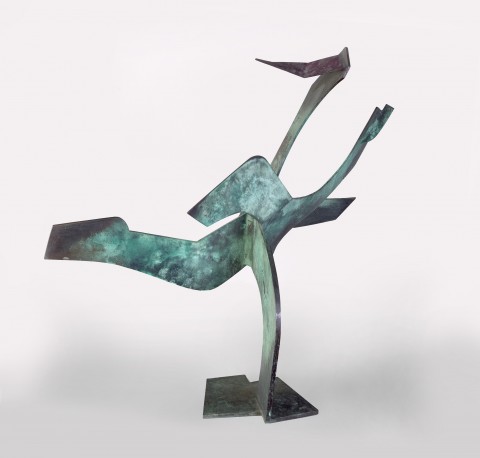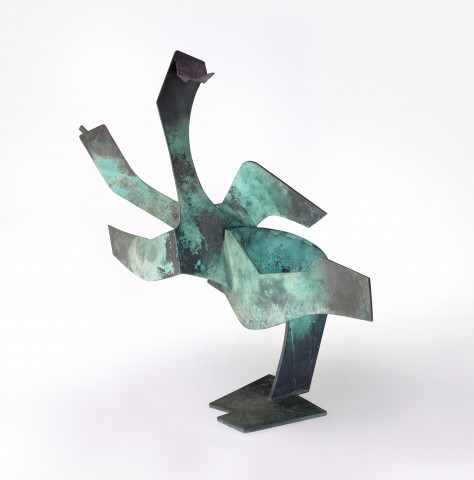NAYADS, 1993
INGE KING
bronze
114.0 x 120.0 x 52.0 cm
Australian Galleries, Melbourne
Private collection, Melbourne, acquired from the above in 1994
Inge King, Australian Galleries, Melbourne, 8 August – 3 September 1994, cat. 5
Trimble, J., Inge King SCULPTOR, Craftsman House, Sydney, 1996, pp. 164, 165 (illus.), 206
Grishin, S., The Art of Inge King Sculptor, Macmillan Art Publishing, Melbourne, 2014, p. 374
Nayads Maquette, 1993, bronze, 37.5 x 40.0 x 18.5 cm, formerly in the collection of the artist
Nayads II, 1996–97, patinated bronze and synthetic polymer paint, 232.6 x 278.0 x 117.3 cm, in the collection of the National Gallery of Victoria, Melbourne
At the time of her death in 2016 at the age of 100, Inge King’s work had transformed her hometown of Melbourne, with monumental sculptures such as Forward Surge, 1974 at the Arts Centre; Shearwater, 1994 – 95 at Southbank; and Sentinel, 2000 on the Eastern Freeway, becoming iconic city markers – recognised by tens of thousands of people, even if they remained unaware of the name or extraordinary achievements of the artist who made them.
When King emigrated to Australia with husband and fellow artist Grahame in 1951, she had already trained in Berlin, Glasgow, London and New York, accumulating considerable experience as a sculptor. Just two years later, she was one of the founding members of the Group of Four (along with Julius Kane, Clifford Last and Norma Redpath), which was established with the collective desire to create a sympathetic relationship between modern abstract sculpture and architecture. The Group was joined by Vincas Jomantas, Lenton Parr and Teisutis Zikaras in 19611, becoming Centre 5 – a seminal coterie that continued to champion a greater appreciation of modern sculpture and the inclusion of ambitious sculpture in contemporary Australian architecture.
As one of the first Australian sculptors to learn to weld2, King began to work exclusively in welded steel from the mid-1960s, creating work that could withstand Australia’s harsh conditions and hold its own in what seemed to her to then be a ‘strange, untidy landscape’.3 However, over time, she came to love and better the understand the Australian bush, with its cast of unique birds becoming part of her lexicon of totemic figures in the 1990s.
This influence is clearly evident in Nayads, 1993, whose abstracted bird-like form seems to dance and leap, its expressive and free movement capturing the joy and playfulness of the female nymphs of Greek mythology referenced in its title. While registered with surprise, King’s shift to figuration in the early 1990s – described by Charles Green in Artforum International as ‘an intensely cosmopolitan revision of Modernist abstraction’4 – was a resounding conceptual and critical success. Interestingly, it also led to new working methods for the artist, with King initially making and arranging shapes cut from paper, and then balsawood, before having these balsawood sections either cut in steel or, in the case of Nayads, sand-cast in bronze and patinated. Once returned from the foundry to the artist, these parts were then arranged into forms and soldered together, leading to fascinating combinations based on the art of assemblage and collage.
The National Gallery of Victoria was to mount the major survey of King’s work, Inge King: Sculpture in 1992, with these recent works serving as an indication of exciting new directions in the artist’s practice. Made in the year following the NGV exhibition, Nayads was to become the catalyst for the Gallery’s commission of second version of the sculpture – Nayads II, 1996 – 97, realised at a larger scale, and for which the Gallery sought permission from the owner of the original work in order to proceed.
1. The exact date of Centre 5’s formation has been long contested. This is the date ascertained by Jane Eckett from Lenton Parr’s diaries in his papers in the State Library of Victoria, Melbourne. See Eckett, J. ‘Binary Star: Inge and Graham King’ in Hurlston, D. & Jane Eckett, Inge King: Constellation, National Gallery of Victoria, Melbourne, footnote 60, p. 119
2. Scarlett, K., ‘Tough and Dedicated’, Australian Art Review, Sydney, February – April 2010, p. 48
3. Lancashire, R., The Age, 31 September 1992, at https://igking.info/inge-king-2/inge-king-the-early-years/ (accessed December 2021)
4. Green, C., ‘Inge King’, Artforum International, vol. 31, no. 7, March 1993, p. 108, cited in Hurlston & Eckett, op. cit., p. 19
KELLY GELLATLY



